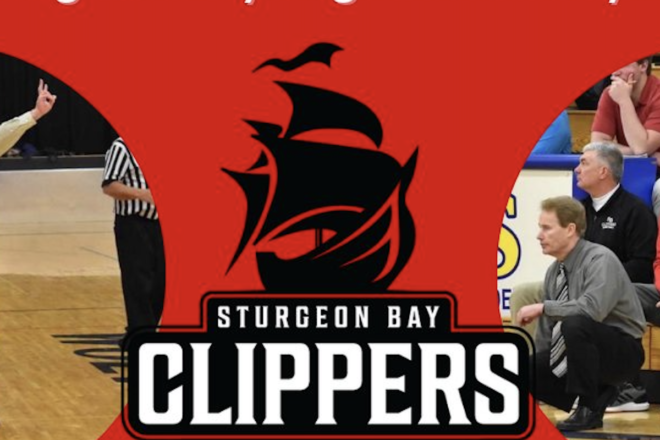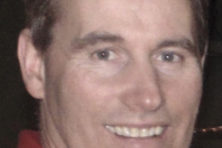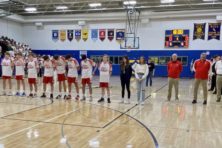Sturgeon Bay to Honor the legacy of Jim Benesh Thursday
- Share
- Tweet
- Pin
- Share

When you step onto the court of a men’s league recreational basketball game and your opponent puts in a mouthguard, you know you’re in for a battle.
That’s what you got with Jim Benesh, a competitive bulldog on the court, on the sidelines, in the dugout and when facing the toughest opponent of his life – cancer.
“If anyone was going to beat this, we thought it was going to be Jim,” said his wife, Amy, a few weeks after Jim succumbed to an aggressive form of multiple myeloma last February at age 56.
Benesh expected to beat it as well, up until his final days. It’s why he never stepped away from prowling the sidelines as coach of the Sturgeon Bay Clippers boys basketball team – the squad he led to more than 400 wins over 27 years, in the gym that still doesn’t feel right without him in it.
“It was unreal,” said his longtime friend Randy Bumgardner. “He had this for two years. He wasn’t going to give up basketball. We mentioned that maybe he should back away, but he wasn’t going to have anything to do with that.”

On Thursday night, when Sturgeon Bay takes on Benesh’s alma mater, Algoma, friends and former players will fill the gym one more time to honor the spirit of a man who pushed them to places they didn’t know they could go. Before the 7 pm game, the school will recognize Benesh’s induction into the Wisconsin Basketball Coaches Hall of Fame – an honor he learned about shortly before he died.
“I’m probably most proud, as a friend, to have helped him get that before he passed,” said Bumgardner, who nominated him for the honor when he realized his friend might not make it much longer. “He was very humbled, but very proud.”
Jim Benesh Night
Thursday, Jan. 12, 7 pm
The late Sturgeon Bay Clippers boys basketball coach and teacher Jim Benesh will be recognized prior to the boys basketball game versus Algoma. Benesh was inducted into the Wisconsin Basketball Coaches Hall of Fame in September.
No Quit
Spencer Hubbard was a senior captain for Benesh’s final team, a group that watched his battle firsthand. They saw their coach deteriorate before their eyes each day, but they also saw him fight.
“We saw him every day, because he would show up,” Hubbard said. “That just speaks to how dedicated he is to what he loves. Not everyone would have the strength and the drive to do that through what they’ve been through. I think everyone should fight to do what they love, do what they’re passionate about.”
Benesh grew weaker by the day, and toward the end, he wasn’t strong enough to stand throughout practices or raise his voice without coughing. For a coach who had always used a hands-on approach, it was a struggle.

“It was difficult to watch some days,” Hubbard said. “This was a guy who, if you were being soft in any shape or form, he was going to show you. He’d show you how to play post defense; he’d get right down there with you.”
But at that point, with COVID-19 spreading, Benesh had to stay 10-12 feet from his players and assistants. In team huddles, he wore a mask and sometimes a visor.
“He did it all to be with us,” Hubbard said.
But Benesh wasn’t about to let his players dwell on his condition, Hubbard said.
“The first day he showed up with his head shaved, he told us, ‘Don’t go shaving your heads for me. We got this.’ He didn’t want people to patronize him in any way.”
Early on, players just expected their coach to beat it, as his friends and family expected as well. “Coach Benesh, of all people, is the last person who would stop fighting,” Hubbard said. “Coach is going to get through.”
But as last season wore on, the players grew to understand that it wasn’t whether, but when. And when the news came, reality settled in. Clippers basketball had lost its leader, its head grit man, the personality of the program.
Benesh’s style bled through all levels of Sturgeon Bay basketball, with most players first meeting him in youth leagues and camps. If you were going to be a Clipper, you were going to play the Benesh way – tough defense, full effort. Fifth-graders imagined playing for him someday, and as a result, they came to look up to the current varsity players. You wanted to fit the mold of a scrappy, hard-nosed Benesh player.
“You knew there was an expectation that you were going to work, play hard, give full effort,” Hubbard said.
But with his players, Benesh could also display another side. His friends and players still laugh about “Benishisms”: corny jokes and punchlines, or old movie references that left his players befuddled.
The Nearly Perfect Season
Benesh dreamed of a state title, but his best teams in the early 2000s had the misfortune of competing in the same sectional as Seymour, a buzzsaw that played in seven straight state-championship games from 1999 to 2006, winning three.
Though they never took home a gold ball, his teams created a legend of their own. In 1999-2000, his team featuring Brandon Hansen, Scotty Jacobson, James Larsen, Jon Carmody, Eric DeJardine and Brandon Reubens stormed through the regular season undefeated and rolled into the sectional championship 24-0.
Three seniors – Hansen, Jacobson and Reubens – led that team. Benesh had promoted them to varsity as sophomores in a move that wasn’t popular at the time.
“Jim stuck out his neck for us,” Jacobson recalled. “It was a really formative year. Our practices were not fun. The kids were great, but there was a lot of parent backlash. But it set the ground rules for how the program was going to be.”
One of those rules was that if you busted your butt, you were going to play, no matter your age.
And the coach was going to bust his butt, too. When practice ended, Benesh would watch film or drive to another game to scout a future opponent and dream up a scheme to beat them. His wife and daughter grew accustomed to his postgame routine: plopping himself in his chair in the living room to watch a game film and devour a cheese pizza. He usually fell asleep in that chair.
Benesh had a library of plays and defenses to pull out of the depths of his coaching mind to throw at his opponents.
I witnessed it firsthand while competing against him as a player, then as a coach. There were years when my teams should have walked over his on talent alone, but we were simply out-coached. Up by 10 late in a game, Benesh would pluck a defense out of a hat and stymie us (none more than me), turning a game and a season around in minutes. The occasions when we did beat him were my most satisfying as a coach – a testament to the job he did every year.
More Than a Coach
When Jacobson remembered Benesh, he remembered much more than the Xs and Os.
“He was such a good man,” Jacobson said. “You don’t remember the game plan, the pregame speech. I went through some tough stuff. My 8-year-old cousin, Tracie, just died the week of a big game. Jim and Amy had babysat her. I didn’t know if I could play. It was really, really hard, but playing was therapeutic.
“We won, and after the game, I just felt a ton of emotion. I came into the locker room, and I had to go around the corner and sobbed. Coach walked around the corner, and he was crying, too, and he just gave me a hug. He just knew that I was hurting. Not every coach is like that.”
Mark Zastrow remembers Benesh for something else: as “the first friend I remember having.”
Zastrow, coach of the Algoma girls basketball team for 17 years, was an Algoma third-grader when he met Benesh, an Algoma fourth-grader, at a basketball camp. Those days in the gym turned into summers at the park dreaming up every game they could play.
“He was always the guy that organized stuff. You just knew he was going to be the guy to do that,” Zastrow said. “It always seemed like something he wanted to do. He was always the guy to get the gym open, get a teacher to open it up for us.”
Zastrow also knew that even as his friend, Benesh was going to battle with him.
“He’s a year older than me,” Zastrow said. “Quite often we would get in scraps in practice or pickup games, even as best friends. He had an edge to him that came out quite often.”
When Benesh married Zastrow’s sister, the friends became brothers, and the big brother helped to teach the little brother how to coach.
“I learned so much from him,” Zastrow said. “How to do interviews. How he appreciated his players and the people in his program. How he built the youth feeder program, made sure they were teaching what you were teaching.
“I never thought growing up that I’d be able to impact lives. I’m not going to be a school board member or on city council, so how do you impact your community? How do you feel those rewards? Coaching was that for me and Jim, and Jim was able to do that for 30 years.”
Family
Benesh’s favorite sport was basketball, but his favorite moments came on the softball diamond, where he coached his daughter, Hailey.
“He was so proud of her,” Zastrow said. “He loved seeing her have success in softball, loved working with her.”
Benesh pushed his daughter the way he pushed his other players, but he also knew the line.
“He always had the intuition to push me, but not so far that I hated it,” Hailey said. “He made you want to be better. If someone wanted the gym open early in the morning, he would do it.”

Her dad, she said, was her best friend. If they were on vacation, he would find a softball field or an open parking lot to get some work in. His competitiveness rubbed off on her – something else he was certainly proud of.
But being the spouse or child of a coach isn’t always easy. Amy and Hailey shared their husband and dad with scores of others. They watched him fall asleep watching film, leave early for morning practice, get home late from a scouting run. But they were never jealous of his time.
“We’re both from Algoma,” Amy said. “I knew what I was marrying when I married Jim. To coach for that long has to be a family commitment, but he always made time for us, too.”
“He wanted to make people’s lives better,” Hailey said, “and have fun doing it.”



